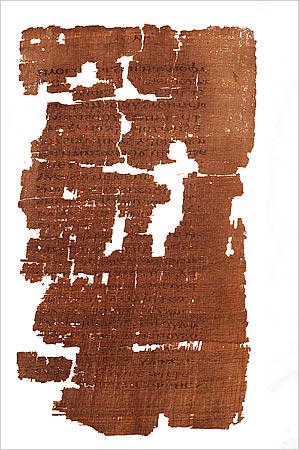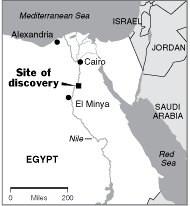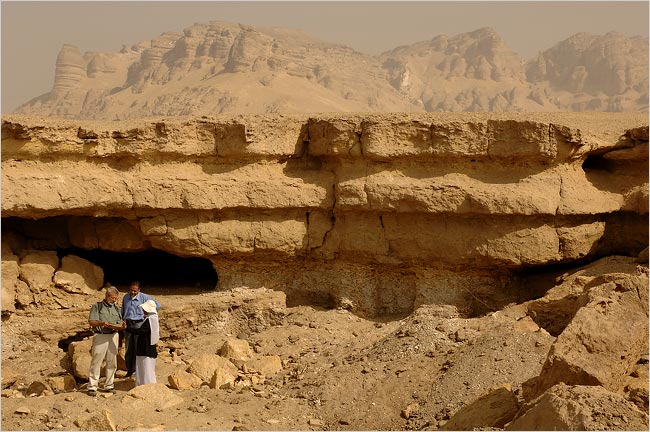| Want to send this page or a link to a friend? Click on mail at the top of this window. |
More Science and Technogy |
| Posted April 7, 2006 |
| In Ancient Document, Judas, Minus the Betrayal |
 |
Kenneth Garrett/National Geographic Society |
| An early Christian document portrays Judas as Jesus' closest ally. |
|
|||
By JOHN NOBLE WILFORD |
|||
and LAURIE GOODSTEIN |
An early Christian manuscript, including the only known text of the Gospel of Judas, has surfaced after 1,700 years, and it portrays Judas Iscariot not as a betrayer of Jesus but as his favored disciple and willing collaborator.
In this text, scholars reported yesterday, the account of events leading to the Crucifixion differs sharply from the four gospels in the New Testament. Here Jesus is said to entrust Judas with special knowledge and ask him to betray him to the Roman authorities. By doing so, he tells Judas, "you will exceed" the other disciples.
"You will be cursed by the other generations, and you will come to rule over them," Jesus confides to Judas in the document, which was made public at a news conference at the National Geographic Society in Washington.
Though some theologians have hypothesized the "good Judas" before, scholars who have translated and studied the text said this was the first time an ancient document lent specific support to a revised image of the man whose name in history has been synonymous with treachery.
Scholars say the release of the document will set off years of study and debate. The debate is not over whether the manuscript is genuine — on this the scholars agree. Instead, the controversy is over its relevance.
Already, some scholars are saying that this Gospel sheds new light on the historical relationship between Jesus and Judas. They find strands of secret Jewish mysticism running through the beliefs expressed by some branches of early Christianity.
But others say the text is merely one more scripture produced by a marginalized Christian cult of Gnostics, who lived so many years after Jesus' day that they could not possibly produce anything accurate about his life. For these reasons, the discoveries are expected to intrigue theologians and historians of religion and perhaps be deeply troubling to some church leaders and lay believers.
"We will be talking about this gospel for generations to come," said Marvin Meyer, a professor of religion at Chapman University in Orange, Calif.
The discovery in the desert of Egypt of the leather-bound papyrus manuscript, its wanderings through Europe and Long Island, and now its translation, were announced by scholars assembled by the National Geographic Society. The 26-page Judas text is believed to be a copy in the Coptic language, made around A.D. 300, of the original Gospel of Judas, written in Greek the century before.
Terry Garcia, an executive vice president of the society, said the manuscript, or codex, was considered by scholars to be the most significant ancient, nonbiblical text found in the past 60 years. Previous major discoveries include the Dead Sea Scrolls, which began coming to light in the late 1940's, and the Nag Hammadi monastery collection of Gnostic writings found in 1945 in Egypt.
 |
The New York Times |
| The manuscript was found in Egypt, near a cavern in El Minya. |
The latter, including gospels of Thomas and Mary Magdalene, have inspired recent Gnostic scholarship and shaken up traditional biblical scholarship by revealing the diversity of beliefs among early followers of Jesus. Gnostics believed in a secret knowledge of how people could escape the prisons of their material bodies and return to the spiritual realm from which they came.
"These discoveries are exploding the myth of a monolithic religion and demonstrating how diverse — and fascinating — the early Christian movement really was," said Elaine Pagels, a professor of religion at Princeton who specializes in studies of the Gnostics.
Mr. Garcia said, "The codex has been authenticated as a genuine work of ancient Christian apocryphal literature," citing extensive tests of radiocarbon dating, ink analysis and multispectral imaging and studies of the script and linguistic style. The ink, for example, was consistent with ink of that era, and there was no evidence of multiple rewriting.
"This is absolutely typical of ancient Coptic manuscripts," said Stephen Emmel, professor of Coptic studies at the University of Münster in Germany. "I am completely convinced."
 |
Kenneth Garrett/National Geographic Society |
| The Gospel of Judas, found near caves, may provide much material for Christian theologians to debate in the years ahead about the time before Jesus' death. |
Experts said the handwriting appeared to be that of a single professional scribe. He is anonymous, as is the original author in Greek.
The word "gospel" means "good news," and generally refers to accounts of Jesus' life. Though someone is named in each, the titles are not necessarily those of the true authors. The consensus of scholars is that the four canonical gospels — Matthew, Mark, Luke and John — were probably not written by any of the original disciples or first-person witnesses to the life of Jesus, although they were probably written within the first century.
Scholars have long been on the lookout for the Gospel of Judas because of a reference to what was probably an early version in a treatise written by Irenaeus, the bishop of Lyons, in 180. He was a hunter of heretics, and no friend of the Gnostics, whose writings proliferated in the second through fourth centuries.
"They produce a fictitious history of this kind, which they style the Gospel of Judas," Irenaeus wrote.
Unlike the four standard gospels, the Judas document portrays Judas Iscariot as alone among the 12 disciples to understand Jesus' teachings.
Karen L. King, a professor of the history of early Christianity at Harvard Divinity School, who is not involved in the Judas project, said this gospel might well reflect the debates that arose in the early centuries.
"You can see how early Christians could say, if Jesus' death was all part of God's plan, then Judas's betrayal was part of God's plan," said Dr. King. The standard gospels either give no motivation for Judas's betrayal or attribute it to the pieces of silver or the influence of Satan.
At least one scholar, James M. Robinson, said the new manuscript did not contain anything likely to change traditional understanding of the Bible. Dr. Robinson, a retired professor of Coptic studies at Claremont Graduate University in California, was thegeneral editor of the English edition of the Nag Hammadi collection. "Correctly understood, there's nothing undermining about the Gospel of Judas," he said.
Dr. Robinson noted that the gospels of John and Mark both had passages that suggest that Jesus not only picked Judas to betray him, but actually encouraged Judas to hand him over to those he knew would crucify him.
In a key passage in the new-found gospel, Jesus had talks with Judas "three days before he celebrated Passover." That is when Jesus is supposed to have referred to the other disciples and said to Judas:
"But you will exceed all of them. For you will sacrifice the man that clothes me." By that, scholars said, Jesus seems to have meant that in helping him get rid of his physical flesh, Judas will act to liberate the true spiritual self or divine being within Jesus.
Rodolphe Kasser, a Swiss scholar of Coptic studies, directed the team that reconstructed and translated the script, which was written on 13 sheets of papyrus, both front and back. The manuscript was a mess of more than 1,000 brittle fragments.
The effort, organized by the National Geographic Society, was supported by Maecenas Foundation for Ancient Art, in Basel, Switzerland, and the Waitt Institute for Historical Discovery, an American foundation.
The 66-page codex also contains a text titled James, a letter by Peter and pages provisionally called Book of Allogenes, or Book of Strangers.
Discovered in the 1970's in a cavern near El Minya, Egypt, the document circulated for years among antiquities dealers in Egypt, then Europe and finally in the United States. Dr. Robinson, of Claremont, said that an Egyptian antiquities dealer offered to sell him the codex in 1983 for $3 million, but that he was unable to raise the money.
The manuscript moldered in a safe-deposit box at a bank in Hicksville, N.Y., for 16 years before being bought in 2000 by a Zurich dealer, Frieda Nussberger-Tchacos. The manuscript was then given the name Codex Tchacos.
When efforts to resell the codex failed, Ms. Nussberger-Tchacos turned it over to the Maecenas Foundation for conservation and translation. Ted Waitt, founder and former chief executive of Gateway, said the Waitt Institute gave the geographic society a grant of more than $1 million for the restoration.
Officials of the project announced that the codex would ultimately be returned to Egypt and housed in the Coptic Museum in Cairo. For now, the Gospel of Judas will be the center of attention in a television show, magazine article, two books and an exhibition by National Geographic.
Copyright 2006 The New York Times Company. Reprinted from The New York Times, National, of Friday, April 7, 2006.
Related text: Document Is Genuine, but Is Its Story True?
| Wehaitians.com, the scholarly journal of democracy and human rights |
| More from wehaitians.com |